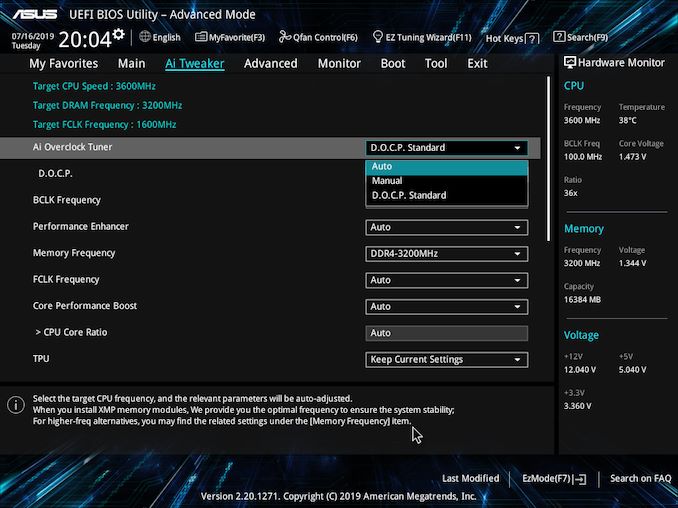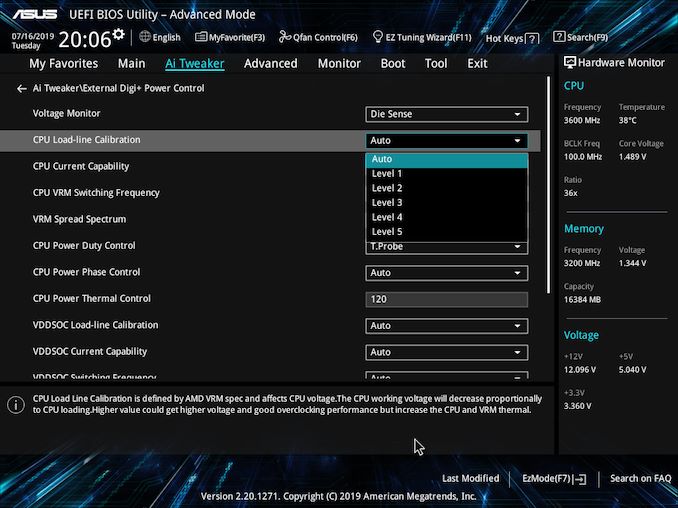The ASUS Pro WS X570-Ace Review: x8x8x8 with No RGB
by Gavin Bonshor on August 12, 2019 9:00 AM ESTOverclocking Ryzen 3000
Experience with the ASUS Pro X570-Ace
The expected overclocking potential prior to the launch of the Ryzen 3000 series hasn't lived up to all the hype that was surrounding it. Regardless of this, the limitations could be in the new 7 nm manufacturing process, the use of the chiplet design, or the very high temperature that these processors run at when overclocked. It remains to be seen in the next revision whether or not the clock speeds will be more fruitful for what enthusiasts expect, but when overclocking the Ryzen 3000 processors, premium cooling methods such as high-end AIOs and custom water cooling is needed.
Overclocking our Ryzen 7 3700X using the ASUS Pro WS X570-Ace via the firmware was easy without much pomp and show. All of the overclocking options including both the CPU, memory, voltage and power settings can be found within the Ai Tweaker section. Users can either opt to use the basic overclocking functions within the AI Suite 3 software or use the acclaimed Ryzen Master overclocking software which as far as AMD overclocking goes, works very well. When overclocking the memory on ASUS branded AMD motherboards, what is more commonly known as X.M.P is called D.O.C.P; this is the exact same thing, no difference, just a different naming structure.
The power-related settings can be found under the External Digi+ Power Control menu, with options for variables such as Load-Line Calibration which is useful for eliminating VDroop on the CPU VCore, VDDSoC settings, and enabling or disabling spread spectrum. There are no real overclocking presets to select from and that's okay given that this model is more for professional users, but there are three performance enhancer settings to select from.
Overclocking Methodology
Our standard overclocking methodology is as follows. We select the automatic overclock options and test for stability with POV-Ray and OCCT to simulate high-end workloads. These stability tests aim to catch any immediate causes for memory or CPU errors.
For manual overclocks, based on the information gathered from the previous testing, starts off at a nominal voltage and CPU multiplier, and the multiplier is increased until the stability tests are failed. The CPU voltage is increased gradually until the stability tests are passed, and the process repeated until the motherboard reduces the multiplier automatically (due to safety protocol) or the CPU temperature reaches a stupidly high level (105ºC+). Our testbed is not in a case, which should push overclocks higher with fresher (cooler) air.
Overclocking Results
The ASUS Pro WS X570-Ace has a capable 12+2 phase power delivery running in 6+1 configuration with an ASP1405I which operates at 6+1. While running the manual overclock testing, we noticed very little VDroop once we ran 3.7 GHz at 1.250 V and above, all the way to 4.3 GHz at 1.375V. This shows that the automatic LLC setting runs pretty much spot on in our testing which means that what voltage is set in the firmware, is the voltage that our Ryzen 7 3700X ran at when under full load.
Performance in our POV-Ray testing from 3.6 GHz to 4.3 GHz showed a consistent increase in performance, and the ASUS Pro WS X570-Ace managed to push our Ryzen 7 3700X to its limitations of 4.3 GHz at 1.375 V. We did go for 4.4 GHz, but even with 1.550 V on the CPU VCore which for the record is way too much, it still wasn't any more stable.
When using the three levels of performance enhancement profiles, we found that they pumped a similar amount of CPU VCore voltage (around 1.375-1.384 V), but it didn't quite match up to the performance in POV-Ray than our manually overclocked 4.3 GHz with 1.375 V. All three profiles we're actually similar to just enabling Precision Boost Overdrive in terms of temperatures, POV-Ray performance and power draw; these are more PBO focused enhancements as opposed to overclocking profiles.













110 Comments
View All Comments
Hul8 - Wednesday, August 14, 2019 - link
APUs (at least 1000 and 2000 series) don't have ECC capability.Hul8 - Wednesday, August 14, 2019 - link
This is provably due to them being separate designs from the modular one of mainstream Ryzen/Threadripper/EPYC; The modular chips *had* to have ECC built in them to support it on EPYC, but AMD has very little reason to dedicate any die area or design resources to it on APUs.Zan Lynx - Friday, August 16, 2019 - link
The APUs don't have ECC support because the Vega does not support it. Since there's a unified memory system, half and half wouldn't work.GreenReaper - Tuesday, August 13, 2019 - link
They support it, but without motherboard support for reporting of status and error handling, it's hard to have any confidence over whether it's actually working.StoltHD - Friday, July 10, 2020 - link
You need to use unbuffered ecc, not registered ecc, so you need to seach a little to get the right sticks, but I run 64GB ECC 2666Mhz at 3000Mhz with my 3900X at 4100Mhz (max speed all core I have managed with stock cooler are 4300Mhz all core and 3000Mhz on ram (no cooling on the ram)CityZ - Tuesday, August 13, 2019 - link
How well will the x8 slot from the chipset work if the chipset itself has only a x4 connection to the CPU and memory?tristank - Tuesday, August 20, 2019 - link
Thats exactly the same question I asked myself.StoltHD - Friday, July 10, 2020 - link
For most calculations and "just for display output" it works welll, but it does not work that good if you have work that need high speed between cpu-gpu ...So for a high perfomance storage WS it can work well, since you can add a Hyper M.2 to the first PCI-E slot for full 16x PCI-E v.4 speed using 4x PCI-E V4 NVME SSD's, but then you can not utilize the second x16 slot ...
If you need 2x or more full 16x PCI-E speed, you need to go Epyc ...
croc - Wednesday, August 14, 2019 - link
I cannot consider any amd x570 MB a WS class MB when it is limited to four DIMMs... The lack of 10GBs network interface has been mentioned. Haven't seen anyone mention the lack of a fourth PCIe x 16 slot or the paucity of of x 4 slots. The only thing that is workstation class on this motherboard (or, indeed across the entire x570 range) is the price. Intel server boards (Tyan, Supermicro) offer much more for similar price. CF Supermicro x11dai-n @587 USD from Amazon...StoltHD - Friday, July 10, 2020 - link
Add the price of the Xeon CPU ...If you go that way you can get a 2x Epyc system for near half the price of a 2x xeon system ,,,
There are epyc motherboards out now with ALL (7-slots) pci-e x16 v.4 ...
(Asrock ROMED8-2T)